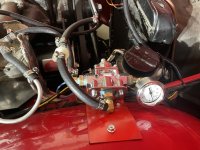Online
I installed my fuel pump pressure regulator. See pic. Nothing I could do would make my floats operate properly and I was continually flooding.
A few days ago, I tried adjusting the floats way up, then way down, and nothing made any difference.
I had near 4 PSI from the pump, and the recommended maximum is 2.5.
I’m not ready to declare victory yet, but I finally have floats that are operating the way the Triumph Manuel suggests. My fuel pressure is now set at near 2.2 psi.
I’m not seeing any flooding, and using the “lift the piston method“ I’m finally able to make some sense of the mixture adjustments. We’ll see.
I’m still not convinced I won’t be towed back home again soon.
A few days ago, I tried adjusting the floats way up, then way down, and nothing made any difference.
I had near 4 PSI from the pump, and the recommended maximum is 2.5.
I’m not ready to declare victory yet, but I finally have floats that are operating the way the Triumph Manuel suggests. My fuel pressure is now set at near 2.2 psi.
I’m not seeing any flooding, and using the “lift the piston method“ I’m finally able to make some sense of the mixture adjustments. We’ll see.
I’m still not convinced I won’t be towed back home again soon.

 Hi Guest!
Hi Guest!

 smilie in place of the real @
smilie in place of the real @
 Pretty Please - add it to our Events forum(s) and add to the calendar! >>
Pretty Please - add it to our Events forum(s) and add to the calendar! >> 

